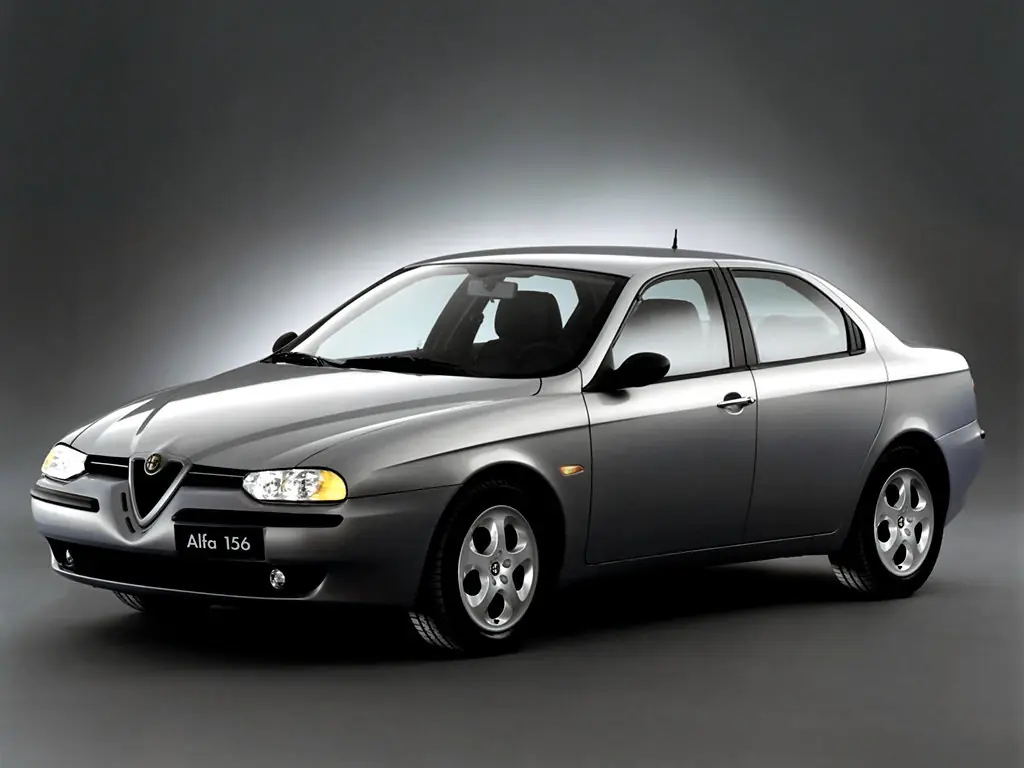The Alfa Romeo 156 burst onto the scene in 1997, immediately grabbing attention with its bold design and driver-focused character. This wasn’t just another entry in the competitive sports sedan segment – it was a statement of intent from the Italian manufacturer, proving they could blend style, performance, and practicality into one compelling package.
Few cars from the late 1990s still turn heads like the 156. Its European Car of the Year award in 1998 merely confirmed what many already knew – Alfa Romeo had created something special. This wasn’t just marketing speak; the 156 genuinely redefined what buyers could expect from a sports sedan.
Design That Still Captivates
The 156’s design speaks volumes about Italian car design philosophy. That distinctive front end, with its shield-shaped grille and aggressive headlights, set a template that Alfa Romeo follows to this day. The hidden rear door handles created a coupe-like silhouette years before this became an industry trend.
At 4430mm long and 1745mm wide, the 156 strikes an ideal balance between presence and maneuverability. Park one next to modern sedans, and you’ll appreciate its compact dimensions and perfect proportions.
“I’ve owned many cars, but nothing turns heads quite like my 156. People still ask me about it in parking lots, and that rarely happens with 25-year-old sedans.” – Michael Chen, 156 2.0 Twin Spark owner
The design details reward closer inspection. Notice how the body lines flow uninterrupted from front to rear, or how the wheel arches subtly flare to suggest contained power. These weren’t random styling decisions – each contributes to the car’s timeless appeal.
Performance That Delivers
The 156’s engine lineup reads like a masterclass in Italian engineering. The star of the show is the 2.0-liter Twin Spark, delivering 155 horsepower through some clever valve timing technology. But numbers don’t tell the whole story.
Here’s what sets the 156’s performance apart:
- double wishbone front suspension delivering precise steering feedback;
- multilink rear suspension system providing exceptional grip;
- perfect 50:50 weight distribution enhancing cornering ability;
- responsive brake system with excellent pedal feel.
The driving experience remains unique. The steering is communicative, the chassis balance is exceptional, and the engines love to rev. This isn’t a car that isolates you from the road – it connects you to it.
Interior: Where Sport Meets Luxury
Step inside the 156, and you’ll find an interior that puts the driver first. The dashboard cants toward the driver’s seat, the instruments are clear and purposeful, and the seats provide excellent support for spirited driving.
“After 200,000 kilometers, my 156’s leather seats still look fantastic. They’ve aged better than those in much more expensive German cars I’ve owned.” – Sarah Williams, long-term owner
The attention to detail impresses. From the hooded instrument cluster to the well-damped switchgear, everything feels deliberately engineered. Yes, some plastics show their age, but the fundamental design and ergonomics remain impressive.
Real-World Ownership Experience
Living with a 156 requires understanding its character. These cars reward proper maintenance and punish neglect. Regular oil changes are crucial, especially for the Twin Spark engines. The timing belt needs changing every 60,000 kilometers without fail.
Key areas to monitor include:
- bodywork around wheel arches and sills;
- electrical system reliability;
- suspension bushings and components;
- cambelt maintenance intervals;
- oil consumption levels.
Regular preventive maintenance pays dividends in reliability and performance. This isn’t a car for those seeking absolute reliability above all else, but it’s perfectly manageable for enthusiastic owners.
A Legacy Worth Preserving
The 156 represents a high point in Alfa Romeo’s recent history. It combines character, performance, and style in a way few modern cars manage. This isn’t just transportation – it’s a driving experience that engages all your senses.
The thrill of driving a well-maintained 156 today remains as potent as ever. In an era of increasing automotive homogenization, its distinctive character stands out even more clearly.
Pros and Cons
| Advantages | Disadvantages |
|---|---|
| Timeless Italian design | Requires regular maintenance |
| Engaging driving dynamics | Body prone to corrosion |
| Excellent handling balance | Parts availability can be challenging |
| Comfortable front seats | Some electrical issues common |
| Strong performance from Twin Spark engines | Fuel consumption higher than rivals |
| Good value for money | Interior plastics show age |
| Unique character and charm | Limited rear seat space |
Despite its flaws, the Alfa Romeo 156 remains a compelling choice for enthusiasts seeking something special. It’s a car that demands more attention than its German rivals but rewards that extra care with an unmatched driving experience and style.

